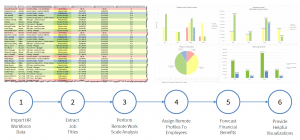
When the pandemic began back in early 2020, so many opinions, theories, and philosophies for the future of the workplace and the impact of remote working were offered and explored. At the time, our collective understanding of what might happen to long-term workforce dynamics was largely conceptual and characterized by uncertainty. Now, as multiple vaccines have become pervasive and real data is becoming available, the reality of the post-COVID workforce is coming into sharper focus. The question isn’t whether companies will be returning their employees to a physical workplace – the real relevant question is how they will do it.
There are several factors driving this reality, but one of the main influencers is the fact that employees simply want to go back to their offices. A recent Glassdoor survey reported by the Society of Human Resources Management revealed that 75% of remote workers are eager to return to the office. In addition, 83% of employees trusted their company’s leadership to decide when and how they will return.
In addition, senior leadership has strong feelings about the need for employees to return to on-site work. James Gorman, the CEO of investment industry leader Morgan Stanley recently remarked, “If you can go to a restaurant in New York City, you can come to the office. And we want you in the office”. Gorman expects employees to wean themselves off of Zoom soon and return to the office, in part, because he equates local New York City compensation with actually working in New York City, not a remote location the offers a lower cost of living.
So, we’ve reached that moment when theory and conjecture is giving way to reality. But, our conversations with clients and business leaders suggest that while it is easier to reach a consensus on the more general aspects of return to work for employees at large, companies are struggling with decisions that optimize the return for each individual employee. How can organizations ensure that they make the right decision for each worker so that they effectively balance the benefits of work location decisions that can vary widely?
One dynamic we’ve seen is that a lack of available tools to manage this specific decision process leads to a more subjective approach that is driven more by opinion than data. How can companies ensure that their overall workforce return decisions are made effectively? How can they employ the right amount of flexibility while applying a clear and confident decision process?
To address this very challenge, T4 has developed two tools designed to help companies navigate the now very real return to work decision framework. The first is our Remote Job Scale. Our research concludes that employers should approach decisions about returning to work at the individual job-description level. This is where the dynamics of remote vs on-site work are the most pronounced, and by determining the correct balance of remove vs on-site work for each individual job, employers will successfully make this decision for all employees holding each job. The scale provides four basic groups into which individual jobs and employees should be categorized that allow for fully on or off-site profiles as well as hybrid profiles:

Figure 1: Trans4mative Remote Job Scale
In addition to this scale, we also offer a Remote Analysis & Planning Tool that applies 7 specific determinants of remote working success to each individual company job. Our tool quickly and easily imports data from HR systems of record, allows individual weighting of each success factor, and forecasts the correct Remote Job Scale for each job description and individual employee. Further our tool forecasts the benefits available for each employee that include reduced travel time, increased productivity, and real estate savings.

Figure 2: Trans4mative Remote Work Planning Tool
In practice, decisions about return for many job roles are intuitive and relatively easy to reach without heavy analysis. However, without a data-driven approach, there are employees in roles with a less obvious remote-work potential who may be over-looked. Our tool is designed to find impactful roles and job descriptions that may be on the margin or at the edges of remote work decision-making and ensure that they are positioned for success. More frequently, we’re looking for important exceptions rather than obvious choices.
These tools allow us to quickly assist companies chart a specific and balanced course for returning each employee to work. Accordingly, this bottom-up approach helps ensure that the best decisions are being made for the entire workforce. If you’d like to understand how these tools work or would like to apply them to your workforce, we’d be glad to discuss them with you. You can learn more about Workplace 2.0 – our framework for sustainable remote working at https://workplace2.trans4mative.com/intro.
Whatever framework you adopt for return to work decisions, I’m wishing you every success.
Managing Partner @ Trans4mative Advisors
mike.rosenbaum@trans4mative.com